|
|
Springfield

|
|
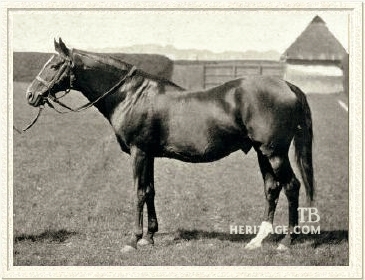 |
|
|
Springfield was one of the fastest horses seen on the turf to his day, and was later a popular sire. He carried on the St. Albans branch of the Stockwell sire line, which thrived well into the mid-twentieth century. It was successful in Europe, the U.S., and South America, and included some of the best steeplechasers of the 1920s-40s. He was the grandsire of two English Triple Crown winners: Rock Sand, who ended up in the U.S., and Galtee More, who became a sire in Russia, and later in Germany. In addition to Galtee More, his daughters produced the unbeaten U.S. racehorse, Colin, Irish Derby winner Blairfinde and Derby winner Ard Patrick (brother and half-brother to Galtee More), One Thousand Guineas winner Galeottia, and the great sprinter and sire, Sundridge, among many other good winners.
Springfield's sire, St. Albans (1857), was the first classic winner for the great "emperor of stallions," Stockwell; he was a bad-tempered stayer whose wins included the St. Leger, the Great Metropolitan Stakes, and the Chester Cup. St. Alban's dam, Bribery, was a winner of five races, including the Goodwood Stakes, who also produced Savernake, runner-up in both the Derby and St. Leger and later a good sire in Germany. Springfield's dam Viridis, owned by Queen Victoria, was by the fast Orlando son, Marsyas, who had won Newmarket's July Cup, and later got a Derby winner in George Frederick. Springfield was born in the Bushey Park Paddocks at Hampton Court in 1873.
He was purchased as a yearling for 320 guineas by J.H. Houldsworth. Houldsworth had had a racing stable at Irvine, Ayrshire, but in the early 1870s established a stud at Newmarket, and Springfield was sent to the newly-established Newmarket Green Lodge stables operated by trainer James Ryan. Ryan had schooled horses for Houldsworth in Scotland, and although he took in and trained animals for other patrons after he moved to Newmarket -- in 1891 he had seventy animals in his barn-- his association with Houldsworth lasted until the latter's death in 1910, and from 1902 to that date became once again a private trainer for Houldsworth. Ryan's winners included Guineas winners Briar Root, Galeottia, Enterprise and Enthusiast, Oaks winner Musa, and a number of other successful runners. But the best of his career was Houldsworth's colt, Springfield.
One of the mares Houldsworth purchased for his new stud, at the dispersal of James Merry's bloodstock, was the good winning filly Sunshine (Coronation Stakes, second in the Oaks). She only produced three winners from fourteen foals for Houldsworth, but as a foundation mare for Houldsworth, established a very successful female family ( Family 1 - h) from daughters and grandaughters, many by Springfield, bred at Houldsworth's stud.
Springfield was a handsome bay colt, with a great length of hip. He ran mostly in sprints, and did not race in the classics, but he showed he could win up to 1-1/4 miles against the stiffest competition. Soon after he was purchased by Houldsworth, he broke his pelvis, but "...thanks to skillful treatment, the mischief was repaired."
Springfield on the Turf
As a juvenile Springfield showed a great deal of class, one of the best of his generation. He started in August, winning his first outing, the Prince of Wales's Plate at York, beating fourteen other youngsters, and went on to win the 6 furlong Gimcrack Stakes by three lengths the next day. In October he won the 4 furlong Two Year Old Stakes at Newmarket, carrying 132 pounds. He then suffered the only two defeats of his career, by running second by a head to Clanronald in the Criterion Stakes, and second to the future Derby winner Kisber, in the Dewhurst Stakes.
At age three he was undefeated, winning nine races, two of which were walk-overs. All but one of these, the ten furlong Free Handicap at Newmarket, were sprint races over five or six furlongs. The wins included the Fern Hill Stakes, the New Biennial Stakes (held the next day, both at Ascot), the Stockbridge Cup, the July Cup at Newmarket, Goodwood's Bagnor Stakes, and the Bradgate Stakes at Doncaster. His walk-overs were the Eglinton Stakes at Doncaster, and the Select Stakes at Newmarket in October. His final race of the season was the Free Handicap, in which he carried the heaviest weight and won by 3/4 of a length, beating four other horses.
At age four he was again undefeated in his five starts, which included the sprint races, the Queen's Stand Plate (5 furlongs, giving away weight), the July Cup (6 furlongs, carrying 133 pounds), the New Biennial Stakes, and the All-Aged Stakes at Newmarket (by 15 lengths against one horse, Ecossais), his last race in October. However, two weeks before the All-Aged Stakes, he was entered in Newmarket's 1-1/4 mile Champion Stakes (carrying 130 pounds), in a field that included the 1877 Derby winner Silvio (118 pounds) and Great Tom, Silvio more noted as a stayer than a speed horse:
Lord Falmouth started Great Tom to make the running for Silvio, which he did to the T.Y.C. winning -post...Here the two favourties were left to themselves, Silvio with the lead; but directly Cannon let Springfield go, he went to the front, and appeared to make Silvio stand still...it was a grand sight to see Mr. Houldsworth's splendid horse going within himself, apparently indifferent whether the winning chair was only a few yards from him or at the top of the town. A great horse, indeed, though it is probably the three-year-olds of 1877 are moderate, this must not detract from Springfield's performance."
|
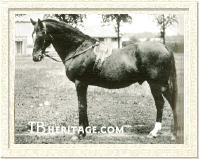
Springfield as an older stallion
| |
Springfield ended his career with 17 wins and two seconds in 19 starts, and earnings of £8,920. Houldsworth placed him at Bushey Paddocks at Hampton Court at a fee of 100 guineas "to a few approved mares." When his second crop of youngsters hit the turf at age two, his fee rose to 200 guineas, the same fee set for Bend Or. Springfield stayed at Bushey Paddocks until the Royal Stud was dispersed, after which he was transferred to Houldsworth's Newmarket stud. He died on March 31, 1898, age 25.
|
Springfield in the Stud
Springfield got two good racing sons, Derby winner Sainfoin, and Watercress, and a classic winning daughter, Briar Root. He got a number of other good winners, and the total amount of winnings of his youngsters was £150,000. But breeders were somewhat leery of Springfield, because his sire, St. Albans had bad legs; it has been said that Springfield did not have the opportunity other high-class sires of the period did, and if one looks at the mares to which he was bred, it's clear he got a few high-class mares, and a lot of modest ones. It was through Sainfoin's son, English Triple Crown winner Rock Sand, that the sire line continued, and spread to America, Australia, and South America. Watercress was also a successful stallion in the U.S. Other than Briar Root, Springfield's daughters were largely a modest lot on the turf, but they were great producers, with horses such as Phalaris, Sundridge, Colin, Limond, Mon Talisman, Campfire and High Time descending from their female families.
|
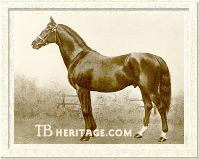
Sainfoin
| |
SAINFOIN was a big sturdy chestnut out of a non-winning Wenlock mare, Sanda, owned by Queen Victoria. Her dam, Sandal, was by Stockwell, making Sainfoin 3 x 3 to that stallion. He was dropped at Bushey Park Paddocks in 1887, and was purchased by the trainer, John Porter, at the Hampton Court annual yearling sale. He won his first and only race at age 2, the 5 furlong Astley Stakes, beating nine youngsters. He came out in April of his second season at Sandown Park, and easily won the Esher Stakes, after which Porter sold him to Sir James Miller. He then won Chester's Dee Stakes over 1-1/2 miles, beating one other horse, and then the Derby, beating Surefoot, Martagon, Orwell, and four others; this Derby had a modest field, and Sainfoin is not considered among the Derby greats.
|
After that, he failed to win. He ran second to Amphion in Ascot's Hardwicke Stakes, fourth in Memoir's St. Leger, and unplaced in the Free Handicap, and at age four he ran third to two indifferent runners over a mile at Hurst Park, and went unplaced in Newmarket's Isleham Plate. In his final season he ran sixth in both the Lincolnship Handicap and in Epsom's City and Suburban, and he was retired to stud by Miller at Barrow's Paddocks at Newmarket, advertised at 50 guineas.
His only good runner was English Triple Crown winner Rock Sand, later purchased by August Belmont and sent to the U.S., where he got Tracery (sent to England), who had an impact on bloodlines in the U.S., Australia (Pantheon-Peter Pan, Cuddle), Europe, England (Papyrus and Obliterate) and South America (Copyright); Tracery also got the famous steeplechase sire, Cottage, and another good steeplechase sire in Monarch. Rock Sand's impact on U.S. bloodlines was through his son, the U.S. champion Friar Rock (a good broodmare sire), but mostly through his daughters, who were bred to Fair Play with great success -- Man o' War was one of many great horses with Rock Sand as dam's sire. As for Sainfoin, beyond Rock Sand his influence is seen through his daughter Bromus, dam of Hainault and Phalaris, and Tout Suite, the dam of Hurry On.
Of Springfield's other sons, WATERCRESS (1889, from Hermit daughter Wharfedale), winner of the Princes of Wales's Stakes and the Hardwicke Stakes, and third in La Fleche's St. Leger, was purchased for $2,400 by James Ben Ali Haggin, and shipped off to California to stand at his famous Rancho del Paso stud. In California he got the champion handicap horse of 1903, Waterboy, second highest money winner in the U.S. that year (behind Haggin's colt Africander); Waterboy pushed Watercress to fourth in the leading sire's list. When Haggin disposed of Rancho del Paso and sold his bloodstock in a series of auctions, Watercress was shipped to New York as part of the dispersal sale and auction at Sheepshead Bay in New York in December of 1905. Haggin re-purchased a number of his horses for his recently-established Elmendorf Stud in Kentucky, and among these was Watercress, for whom he bid $71,000, the second highest auction price ever paid in America (behind Charles Reed's bid of $100,000 for St. Blaise in 1891). In the east, Watercress got Preakness Stakes winners Watervale and Rhine Maiden. He was twice more in the top ten of the leading sire's lists.
Most of Springfield's winners were two year olds; his first crop of 1881 included six juvenile winners, and his second crop had ten. Of his sons that ran at three and older, ALLOWAY (1887, from Lady Morgan by Thormanby) won the Prince of Wales' Stakes and the Great Yorkshire Handicap; BATTLEFIELD (1879, from Quick March by Rataplan) won the St. James Palace Stakes; JOHNNY MORGAN (1885, from the Scottish Chief daughter Lady Mar) ran second to Ayrshire in the 2,000 Guineas. NEAPOLIS (1885, from Napoli by Macaroni (she also the dam of Orvieto and Laveno, both by Bend Or)) was purportedly a promising youngster in trial, but split his pastern, and was not sound after, although he came within a neck of beating Merry Andrew at Epsom, and was sold to Argentina, where he became a good stallion. Springfield's son MORGAN got two highly successful sons in Austria-Hungary, Morpeth (1903, from Vonzo), winner of the Austrian Derby, the Hungarian St. Leger and a number of other races, and Pardon, another winner of the Austrian Derby, who became a good sire; Morgan's daughter, Molly Morgan, winner of the Cambridgeshire Stakes and was later dam of Farasi and other good Irish winners.
Springfield's daughters were not as good as his sons on the turf. His best racing filly was BRIAR-ROOT (1885, from Eglentyne, by Hermit), winner of the Whitsuntide Plate, her only win in four starts at age two, who went on to win the One Thousand Guineas and the Yorkshire Oaks at age three. She became second dam of Prunus, winner of the German St. Leger and an enormously influential stallion in Germany; she is also seen tail-female in such horses as American stakes winners Easter Stockings, Brown Bud, and Toro, and horses such as Hurry Off and Ascot Gold Cup winner Supertello. Her sister, WHITE LILAC (1896) established a female line of influence in Australasia, which included New Zealand St. Leger winner Satrap and New Zealand Oaks winner Idle Jest. A closely-related filly, CAMBUS O' MAY (1891, by Springfield, out of Eglentyne's daughter, Rebecca) became a tail-female ancestress of a number of good Italian stakes winners, including the Italian Derby winning filly Peruviana (1937).
Of his other daughters, SPRING MORN (1881) was a decent juvenile, winner of the International Two-Year-Old plate at Kempton, the Derby Breeder's Foal Stakes and was second in the Champagne Stakes, and at three, in her only running, second in the Yorkshire Oaks. Her decade-younger sister, SPRING RAY, also won the Champion Breeders Foal Plate, and went on to win the Yorkshire Oaks at age three, and some handicaps at age four. Another sister, SUNRISE (1883), won stakes at Kempton and the Richmond Stakes at age two. VICUNA (1891) was a winner of the Abingdon Plate at age three. PONZA (1887) won two races as a juvenile, including the Manchester Breeder's foal plate, and at three won Newmarket's Zetland Plate, the Yorkshire Oaks, and the Park Hill Stakes, and was second in the Oaks, in eleven starts. SPRING GUN (1880) won three of her 15 starts at age two, including the Londesborough Stakes. PASTORELLA (1892), destined to become the dam of the U.S. runner Colin, won a Biennial stakes at Ascot and the Zetland Stakes as a juvenile. WOOD SORREL became the dam of the half-bred Sister May, by the famous runner and sire May Boy; Sister May was a winner and produced a number of good Irish steeplechasers and dams of steeplechasers.
His Crosses with Sunshine and her Daughters
A great many winners were bred at Houldsworth's Newmarket stud from his foundation mare, Sunshine (1867, by Thormanby, Family 1 - h) and her daughters; Springfield was bred to both Sunshine and her daughters. As noted above, some of Springfield's daughters from these crosses were successful on the turf, and might have been more successful had Houldsworth not insisted on running many of his youngsters beyond their class.
From his unplaced (ran once, in the Molyneux Plate) daughter, SUNDOWN (1887), out of Sunshine, came two fillies important in American bloodlines, produced after she was shipped pregnant and with an Ayrshire foal (Peep o' Day) at foot to the U.S. to enter the Keene Kentucky stud. The first was Nightfall (by Voter), the dam of the juvenile U.S. Champion, Campfire. The second was Noonday (by Domino), dam of High Time, later a leading sire in the U.S. From the Sunshine-Springfield unraced daughter SUNSHOWER (1888) came the Gran Premio di Milano winner Spartivento (1896, by Le Sancy), and a number of good stakes winners, including the Italian crack Vezzano (1936, by Ortello) descended from his sister, Ventimiglia (1893).
Springfield was used extensively on Sunshine's daughters, Sunray (1874, by King of the Forest), Napoli (1878, by Macaroni), and Helioscene (1886, by Hampton). In addition to the aforementioned NEAPOLIS, Napoli, to the cover of Springfield, produced PONZA (noted above), a winner of six races, and in the stud Ponza produced Positano, who became an influential sire in Australia. Later, she was also the dam of German Oaks winner Pfaueninsel, and two other classic winners, Pomp and Pathos, in Germany.
Helioscene's daughters HAZY (1892), PHOTO (1894), SCENE (1895), MULTRUE (1896) and GLASS (1898) were all by Springfield. HAZY, a small filly who was a winner, became the dam of Cesarewitch winner Balsarroch (by Martagon). PHOTO had only six living foals, but among them was Waiontha, the unbeaten winner of five races as a juvenile, and probably the best of her generation at that age, although she was unable to win at age three. PHOTO (1894) bred on, with stakes winners descending from her. SCENE (1895) established a sturdy branch of the Sunshine family, which included grandson Buen Ojo, winner of the Gran Premio Jockey Club, and the great French stayer of the '20s, Mon Talisman. GLASS produced Ebor Handicap winner Wuffy (1903), and her female line bred on into the 1970s. MULTRUE's female line had winners through the 1940s.
Sunray produced three daughters of significance to the cover of Springfield. They were SPRING MORN (1881), SUNRISE (1863) and SPRING RAY (1891), all of them stakes winners. SUNRISE was the only one that produced high-class runners in the first generation, with son Dunure (1889, by St. Simon) a winner of the Great Yorkshire Stakes and Coventry Stakes and other races, with total winnings of £6,855, and Greenan (1895) also a winner of the Great Yorkshire Stakes; Dunure was sold to Austria-Hungary and became a good sire there, and he was later joined, via the U.S., by Greenan. However, one of her daughters, Lindal (1902) was the dam of Limond (Exeter Stakes), who became an important sire in New Zealand, and of Sandal, who was influential in Argentina (sire of Macon). Another of Sunrise's daughters, Greeba (by Melton), was the dam of the good runner and moderately successful broodmare sire, Eager (by Enthusiast, winner of the July Cup, Rous Memorial Stakes and later a successful sire in Ireland), and her line bred on. Hainault and the extraorindarily influential sire Phalaris were out of Bromus (by SAINFOIN), a grandaughter of Sunrise, and thus both were in-bred to Springfield. Greeba's line has remained active through the 20th century.
SPRING MORN, produced Golden Morn, who produced a winner before dying of a twisted gut. Spring Morn's other daughters were sold abroad; one was a slight, unraced filly, Otterden (1896) by Sheen, who went to New Zealand, carrying Martian (by Martagon), who became a successful sire of broodmares. SPRING RAY became the fourth dam of One Thousand Guineas winner Pillion (1923, by Chaucer); Pillion's tail-female descendants included Doncaster Cup winner Aldborough and Irish classic winner Kythos.
Other Springfield Daughters
Tracing the descendants of a number of Springfield's daughters will eventually yield a familiar stakes winner's name. Four daughters deserve special attention: MORGANETTE (1884, from Lady Morgan, by Thormanby); PASTORELLA (1892, from Griselda, by Strathconan); AGAVE (1894, from Wood Anemone by King of the Forest); and SIERRA (1889, from Sanda, by Wenlock, and so a sister to SAINFOIN).
|
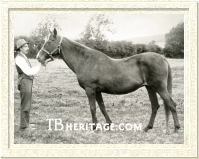
Morganette
| |
MORGANETTE, bred by Houldsworth, had raced once, in the Prince of Wales's Stakes at Goodwood, in which she was unplaced, and she also proved to be a roarer. She was also "very mean looking and muley." She was sold for somewhere between £200 and £600 (depending on the teller of the tale), to Irish sportsman John Gubbins, who had been a steeplechase enthusiast who had sold most of his jumping stock when he inherited Knockany Stud in Ireland from his brother in 1879, determined to enter the world of flat racing. He did keep back a backwards colt from his jumping stock, by Xenophon, and later took him to France, where with Gubbins as jockey, he won the Grand Hurdle Race at Auteuil. He then sold the colt to Lord Manners, who took the horse, called Seaman, to the Grand National Steeplechase of 1882, which he won; Gubbin's horse, Cyrus, ran second to Seaman in that race.
|
Gubbins also developed the famous half-bred May Day family at Knockany Stud, having purchased her dam, Larkaway, whom he bred to the good jumper sire Uncas to produce May Day.
MORGANETTE'S dam, the unraced Lady Morgan, would later produce the useful runner ALLOWAY to the cover of Springfield. Put in the stud at age three, MORGANETTE produced ten foals for Gubbins, becoming the foundation mare of Knockany Stud, most often bred to Gubbin's stallions Kendal (later sent to Ojo de Agua Stud in Argentina) and St. Florian, who died after only a few years at Knockany. She produced the unraced half-bred filly Annette (by Mayboy), who in turn produced the winners Aria and Quick March; next was the chestnut Marietta by Kendal, winner of 4-1/2 races and £1210, later dam of Isalian Beauty. Then came Blairfinde (1891), by Kendal, who won the Irish Derby and got some good runners as a sire.
After producing a dead colt and an unraced colt, both by Kendal, in 1894 MORGANETTE dropped the big Galtee More, winner of England's Triple Crown races, the second Springfield grandson to attain that rare distinction. Galtee More won four of his five races as a juvenile, his second loss was by a short head in the Great Lancashire Breeders' Produce Stakes at Liverpool. At age three he won seven of his eight races, which, in addition to the three classics, included the Prince of Wales's Stakes, the Sandringham Cup, the Newmarket Stakes and the Sandown Foals Stakes, the latter two over 1-1/4 miles. His loss came in the Cambridgeshire, in which he carried 26 pounds more than the other 3 year olds in the race, finishing fifth, and about a length behind the winner, Comfrey. Because he was having tendon problems, he did not train on at age four, and at age four was sold to the Russian government for 20,000 guineas, where he got Irish Lad, a big winner in Russia; in 1904 he was sold on to the German stud at Graditz for £14,000, where he was also successful, getting the multiple leading sire Fervor and winners of 309 races over five years. He died enroute to the Union Stud at Hoppegarten in January of 1917, having slipped while being loaded onto the train and fracturing his leg.
Blairfinde and Galtee More weren't MORGANETTE'S only good sons, however. In 1899 she dropped Ard Patrick, by St. Florian. He went on to win the Derby, the Princess of Wales's Stakes and the Eclipse Stakes. At age four, he was sold to Count Lehndorff for 20,000 guineas, and sent to Germany. He was a successful stallion there, his daughter, Antwort, a good stakes winner and one of the most significant broodmares ever to be bred in Germany. MORGANETTE died in December of 1909, and was buried at Knockany Stud, next to her constant companion, the great half-bred mare, Mayday, dam of Mayboy, Maygirl, Queen May and Kendal Belle. Within the inscription on her monument are the words, "immortalised this stud."
|
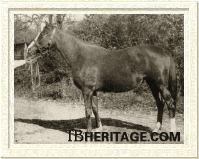
Pastorella. Photo couresy Liz Martiniak.
| |
PASTORELLA a modestly successful juvenile winner, was purchased by Copper King Marcus Daly and shipped to his Montana Bitter Root Stud. After his death, she was bought by James Keene and entered his Castleton Kentucky stud, and at Keene's dispersal in 1913 was bought by E.R. Bradley, and then went to John Madden; having made the rounds of all the important Kentucky studs, she was purchased, age 24, by R.T. Wilson, with the intent of breeding her to his stallion, Olambala, the sire of Campire (grandson of the Springfield daughter, Sundown).
|
At Castleton PASTORELLA produced Commando's undefeated son (15 races at ages 2 and 3), Colin, which both Keene and his farm manager Major Daingerfield considered the best horse ever bred at the famous Castelton farm, and many felt was one of the best ever produced in America. In the stud he only got 81 foals, eleven of which were stakes winners. His son Neddie, winner of five races, got Good Goods, sire of Alsab. His daughters had some influence in American breeding, as did another son, On Watch.
AGAVE, a daughter of Wood Anemone by King of the Forest, did not place in her single race as a juvenile, and at age three, ran third in the Rous Memorial Stakes, her only placing in her five starts. She produced Galeottia (by Galopin), winner of the Keptom Park Two Year Old Stakes as a juvenile, and at age three of the One Thousand Guineas, placing second to La Sagesse in the Oaks, and in the Knowsley Dinner Stakes. At age four she won the Great Yarmouth Handicap. Galeottia became the dam of Gay Laura, a modest winner as a juvenile, who produced Gay Crusader, winner of the wartime English Triple Crown, and later a leading broodmare sire in France. She also produced Manilardo, winner of the Coronation Cup, and a daughter, Bergamotte, who bred on. Galeottia was also dam of Highness, ancestress of some good stakes winners.
SIERRA, sister to Sainfoin, and to VETCH (1890) who bred on, produced three good runners. Her son Elmstead (by Amphion) won the Steward's Cup, the Brighton and Sussex Plates and several other races, and ran second to good horses a number of times; he went to Argentina as a stallion. Her daughter Amphora (1893, by Amphion) won the Gimcrack Stakes and the Steward's Cup, and established a nice sub-family (2 - g) that included Caufield Cup winner Lucknow, later a sire, Melbourne Cup winner Catalogue, Irish Derby winner Raeburn, and a great many more stakes winners. But the most influential of Sierra's offspring was Sundridge, who like his grandsire, injured his pelvis as a youngster, and became a roarer, to boot. Despite this, he ran 38 times, never over 6 furlongs, winning the July Cup three times, the King's Stand Stakes three times, the Teddington Plate, twice, and other races, usually conceding great amounts of weight to his opponents. In 1911 he led the sire's list in all divisions, and in 1914 was again leading sire, as well as leading sire of juveniles, and later, was a leading broodmare sire.
--Patricia Erigero
|
|
|
|

